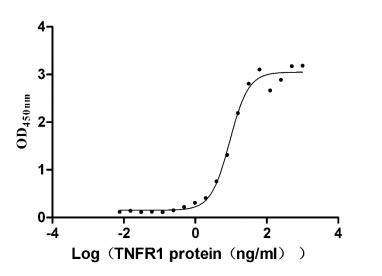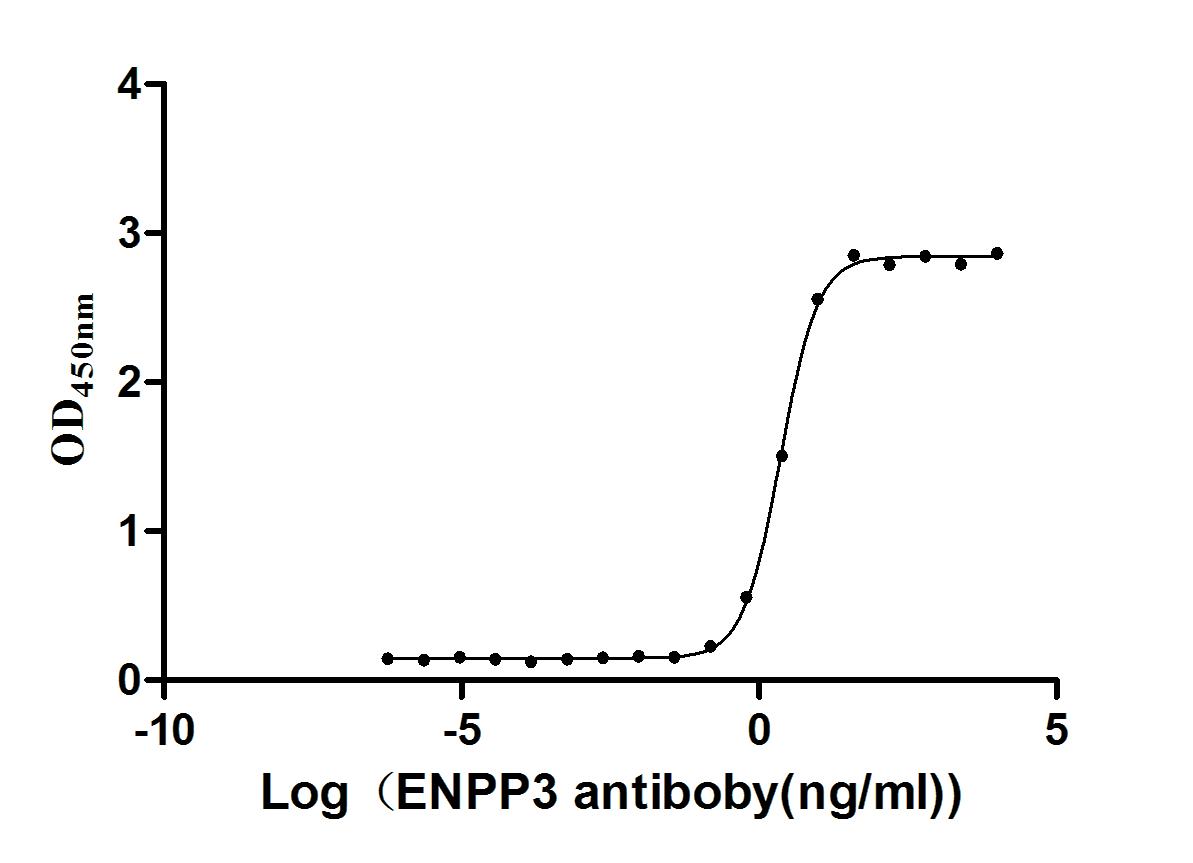Recombinant Mouse BCL2/adenovirus E1B 19 kDa protein-interacting protein 3 (Bnip3)
In Stock-
货号:CSB-CF002766MO
-
规格:¥9720
-
图片:
-
其他:
产品详情
-
纯度:Greater than 85% as determined by SDS-PAGE.
-
基因名:
-
Uniprot No.:
-
别名:Bnip3; Nip3; BCL2/adenovirus E1B 19 kDa protein-interacting protein 3
-
种属:Mus musculus (Mouse)
-
蛋白长度:Full Length
-
来源:in vitro E.coli expression system
-
分子量:23.8 kDa
-
表达区域:1-187aa
-
氨基酸序列MSQSGEENLQGSWVELHFSNGNGSSVPASVSIYNGDMEKILLDAQHESGRSSSKSSHCDSPPRSQTPQDTNRAEIDSHSFGEKNSTLSEEDYIERRREVESILKKNSDWIWDWSSRPENIPPKEFLFKHPKRTATLSMRNTSVMKKGGIFSADFLKVFLPSLLLSHLLAIGLGIYIGRRLTTSTSTF
Note: The complete sequence including tag sequence, target protein sequence and linker sequence could be provided upon request. -
蛋白标签:N-terminal 10xHis-tagged
-
产品提供形式:Liquid or Lyophilized powder
Note: We will preferentially ship the format that we have in stock, however, if you have any special requirement for the format, please remark your requirement when placing the order, we will prepare according to your demand. -
缓冲液:Lyophilized from Tris/PBS-based buffer, 6% Trehalose
-
储存条件:Store at -20°C/-80°C upon receipt, aliquoting is necessary for mutiple use. Avoid repeated freeze-thaw cycles.
-
保质期:The shelf life is related to many factors, storage state, buffer ingredients, storage temperature and the stability of the protein itself.
Generally, the shelf life of liquid form is 6 months at -20°C/-80°C. The shelf life of lyophilized form is 12 months at -20°C/-80°C. -
货期:3-7 business days
-
注意事项:Repeated freezing and thawing is not recommended. Store working aliquots at 4°C for up to one week.
-
产品描述:
This recombinant MouseBnip3 protein is an in vitro E.coli (cell-free) expressed Full Length protein. Its purity is 85%+ determined by SDS-PAGE. Cell-free protein expression is the in vitro synthesis of a protein using translation-compatible extracts of whole cells. In principle, whole-cell extracts contain all the macromolecules and components needed for transcription, translation, and even post-translational modification. These components include RNA polymerase, regulatory protein factors, transcription factors, ribosomes, and tRNA. When supplemented with cofactors, nucleotides, and the specific gene template, these extracts can synthesize proteins of interest in a few hours.
Bnip3, a pro-apoptotic BH3-only protein of the Bcl-2 family, is involved in apoptosis, programmed necrosis, autophagy, and mitophagy in the process of cells and tissues exposed to hypoxia or ischemia. In addition to involvement in cell death and metastasis-associated processes, Bnip3 can also regulate different metabolic pathways, such as lipid metabolism, glycolysis, and mitochondrial bioenergetics. Bnip3 also plays a critical role in carcinogenesis. Upregulated expression of Bnip3 has been reported in lung, prostate, cervical tumors, and breast cancers. Increased Bnip3 expression has been linked to the aggressive tumor phenotype and a dismal prognosis. -
Datasheet & COA:Please contact us to get it.
相关产品
靶点详情
-
功能:Apoptosis-inducing protein that can overcome BCL2 suppression. May play a role in repartitioning calcium between the two major intracellular calcium stores in association with BCL2. Involved in mitochondrial quality control via its interaction with SPATA18/MIEAP: in response to mitochondrial damage, participates in mitochondrial protein catabolic process (also named MALM) leading to the degradation of damaged proteins inside mitochondria. The physical interaction of SPATA18/MIEAP, BNIP3 and BNIP3L/NIX at the mitochondrial outer membrane may play a critical role in the translocation of lysosomal proteins from the cytoplasm to the mitochondrial matrix. The physical interaction of SPATA18/MIEAP, BNIP3 and BNIP3L/NIX at the mitochondrial outer membrane regulates the opening of a pore in the mitochondrial double membrane in order to mediate the translocation of lysosomal proteins from the cytoplasm to the mitochondrial matrix. Plays an important role in the calprotectin (S100A8/A9)-induced cell death pathway.
-
基因功能参考文献:
- High-fat-mediated liver damage is associated with Sirt3 downregulation, which is followed by ERK-CREB pathway inactivation and Bnip3-mediated inhibition of mitophagy, causing hepatocytes to undergo mitochondria-dependent cell death. PMID: 30056271
- JNK activates Mff and Bnip3, contributing to the fatal mitochondrial fission and mitophagy, respectively. PMID: 29149759
- BNIP3 expression was upregulated in hypoxic keratinocytes, and BNIP3 silencing suppressed hypoxia-induced cell migration. PMID: 27783443
- In a neuronal model of dominant optic atrophy, BNIP3 down-regulation reduced autophagy and mitophagy. PMID: 27861891
- Down-regulation of Bcl2/adenovirus E1B 19-kDa-interacting protein 3 (BNIP3) by olomoucine, a cyclin-dependent kinasesinhibitor, reduces lipopolysaccharide - and nitric oxide-induced cell death in BV2 microglial cells. Olomoucine may protect cells by limiting proinflammatory responses, thereby reducing nitric oxide generation. PMID: 27345388
- data outline Bnip3 as a key effector of PPARgamma-mediated adipose mitochondrial network fragmentation, improving insulin sensitivity and limiting oxidative stress. PMID: 27325287
- the results suggest that BNIP3 plays a vital role in regulating PINK1 mitochondrial outer membrane localization, the proteolytic process of PINK1 and PINK1/parkin-mediated mitophagy under physiological conditions. PMID: 27528605
- BNIP3 interacts with the mitochondrial outer membrane directly via mitochondrial BAX. PMID: 28333095
- Data show that TGFbeta-activated kinase-1 (TAK1) activated nuclear factor of activated T-cells (NFAT)/NF-kappa B (NFkappaB), downregulated BCL2-adenovirus E1B interacting protein 3 (Bnip3), and inhibited cardiac cell death. PMID: 26564789
- propose that BNIP3 acts as a brake on HIF-1 activity serving to increase rates of mitophagy in response to hypoxia and to limit production of damaging ROS that would further amplify HIF-1 expression and promote tumor progression to metastasis PMID: 26232272
- Results suggest that Bnip3 regulates cardiac gene expression and perhaps myocyte morphology by activating nuclear p300 acetyltransferase and hyperacetylating histones and its selective transcription factors. PMID: 26317696
- Bnip3 dual-functionality and crosstalk between mitophagy and apoptosis pathways is presented here. PMID: 26253153
- regulates mitophagy during hypoxia, whereas NIX is required for mitophagy during development of the erythroid lineage. PMID: 25753537
- role in the generation of robust NK cell memory in the process of mitophagy during viral infection PMID: 26253785
- BNIP3 primarily regulates basal level of mitophagy in physiological conditions, whereas BNIP3 exclusively activates excessive mitophagy leading to cell death. PMID: 25230377
- Bnip3 generation, mediated by PARP1, causes mitochondrial damage and neuron death. PMID: 25429139
- Suggest pro-tumorigenic role of BNIP3 driving melanoma cell's aggressive features, like migration and vasculogenic mimicry. PMID: 24625986
- BNIP3 has a protective effect against UVB-induced apoptosis in keratinocytes PMID: 24402046
- The BNIP3 cell death pathway may be a new target for protecting oligodendrocytes from death after stroke PMID: 23692407
- Bnip3 is a required downstream effector of FoxO-driven autophagic flux in mechanically unloaded failing myocardium. PMID: 23568341
- These results uncover a mechanism of cavitation through hypoxia-induced apoptosis of the core cells mediated by HIFs, Bnip3, and AIF. PMID: 22753893
- Loss of BNip3 resulted in increased lipid synthesis in the liver that was associated with elevated ATP levels, reduced AMP-regulated kinase (AMPK) activity, and increased expression of lipogenic enzymes. PMID: 22547685
- our mouse model demonstrates a balance between BNIP3-mediated autophagy and H-ras(val12)-induced tumor formation and reveals that H-ras(val12) induces autophagy in a BNIP3-dependent manner. PMID: 22241963
- The role of HIF-1alpha or NBIP3 in hypoxia-induced authophagy activation and osteoclastogenesis is reported. PMID: 21465467
- Expression of NOV and BNIP3 in leukemia AML-M(4) is significantly higher than that in normal controls. PMID: 21518474
- Suggest that induction of mitochondrial autophagy in response to Bnip3 is a protective response activated by the cardiac myocytes that involves Drp1-mediated mitochondrial fission and recruitment of Parkin. PMID: 21890690
- enforced and endogenous expression of Ras coincided with the up-regulation of BNIP3 across a wide spectrum of cancer cells, providing the first experimental evidence that BNIP3 is a regulatory target of H-Ras PMID: 21868531
- Bnip3 caused an increase in mitochondrial protease activity, suggesting that Bnip3 might promote degradation of proteins in the mitochondria. PMID: 21278801
- findings reveal a novel intrinsic defense mechanism that opposes the mitochondrial defects and cell death of ventricular myocytes that is obligatorily linked and mutually dependent on alternative splicing of Bnip3FL during hypoxia or ischemic stress PMID: 21415393
- Expression of MAFbx and Bnip3 was increased in hearts of mice in bearing colonic tumors. PMID: 21167183
- Bnip3 mediates mitochondrial permeabilization by a novel mechanism that is different from other BH3-only proteins PMID: 20025887
- Bnip3 is important in the cardiomyocyte death pathway after severe hypoxia. PMID: 20160671
- The expression of PLAGL2 leads to the mRNA expression of a proapoptotic factor, Nip3 PMID: 11832486
- Promoter analysis showed that the region between -281 and -1 of the 5'-upstream enhancer region of murine BNIP3 was sufficient for nitric oxide-dependent expression of BNIP3 PMID: 15358175
- Data suggest that Bnip3-mediated upregulation of autophagic activity constitutes a protective response against Bnip3 death signaling. PMID: 16874059
- Results identify BNIP3 as a key regulator of hypoxia-induced autophagy and suggest a novel role for the RB tumor suppressor in preventing nonapoptotic cell death by limiting the extent of BNIP3 induction in cells. PMID: 17576813
- Bnip3/Bnip3L play a crucial role in anthrax lethal toxin-induced cytotoxicity, and down-regulation of Bnip3/Bnip3L is a mechanism of spontaneous or toxin-induced resistance of macrophages. PMID: 17623653
- The study suggests that Bnip3 may actually allow cell survival either by preventing ATP depletion or by eliminating damaged mitochondria. PMID: 17786027
- Bnip3 minimizes ventricular remodeling in the mouse. PMID: 17909626
- These results suggest that BNIP-3 is a candidate for an intrinsic factor related to antidepressive effects and that Wakan-yaku theory may be useful for the identification of other intrinsic functional molecules. PMID: 18606473
- Hepatic BNIP3 was also upregulated in two different models of liver stress in vivo, suggesting that a multitude of inflammatory stresses can lead to the modulation of BNIP3 PMID: 19147804
- chronic intermittent hypoxia could up-regulate the expression of Nip3, and result in neuron apoptosis and ultrastructural changes in neurons of the frontal cortex PMID: 19187620
- Increased cell injury and/or death could be caused directly by the upregulation of bNip3, a preapoptotic molecule that dimerizes with Bcl-2, or indirectly by the aberrant expression of SP-C-induced endoplasmic reticulum stress in epithelial cells. PMID: 19574421
- BNIP3 is an important regulator of caspase-independent neural precursor cell death after hypoxia. PMID: 19915483
显示更多
收起更多
-
亚细胞定位:Mitochondrion. Mitochondrion outer membrane; Single-pass membrane protein.
-
蛋白家族:NIP3 family
-
数据库链接:
KEGG: mmu:12176
STRING: 10090.ENSMUSP00000101718
UniGene: Mm.378890
Most popular with customers
-
Recombinant Human Tumor necrosis factor receptor superfamily member 1A (TNFRSF1A), partial (Active)
Express system: Mammalian cell
Species: Homo sapiens (Human)
-
Recombinant Rabbit Tissue factor pathway inhibitor (TFPI) (Active)
Express system: Mammalian cell
Species: Oryctolagus cuniculus (Rabbit)
-
Recombinant Rat Intestinal-type alkaline phosphatase 1 (Alpi) (Active)
Express system: Mammalian cell
Species: Rattus norvegicus (Rat)
-
Express system: Mammalian cell
Species: Homo sapiens (Human)
-
Recombinant Human Epithelial discoidin domain-containing receptor 1 (DDR1), partial (Active)
Express system: Mammalian cell
Species: Homo sapiens (Human)
-
Recombinant Human Cell adhesion molecule 1 (CADM1), partial (Active)
Express system: Mammalian cell
Species: Homo sapiens (Human)
-
Recombinant Human Myosin regulatory light polypeptide 9 (MYL9) (Active)
Express system: Yeast
Species: Homo sapiens (Human)
-
Recombinant Human Cadherin-17 (CDH17), partial (Active)
Express system: Mammalian cell
Species: Homo sapiens (Human)





















